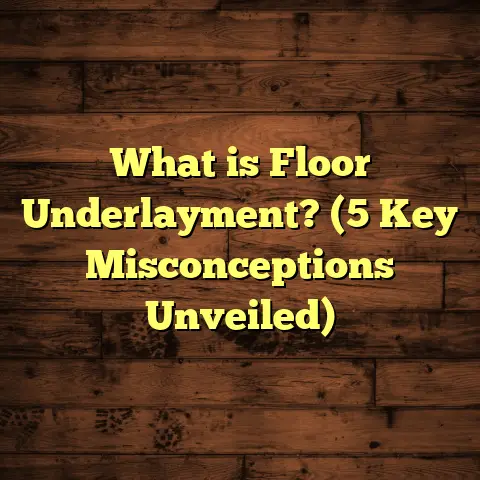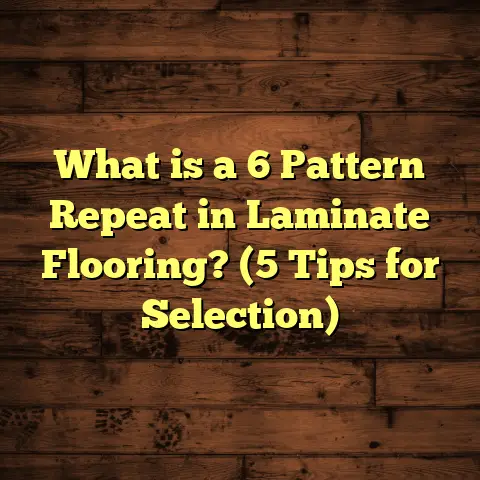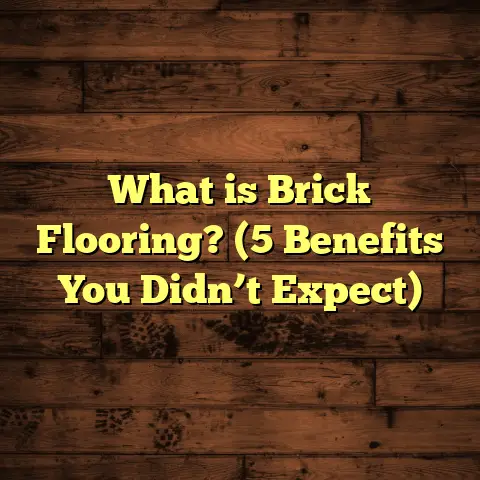What is Engineered Flooring vs Laminate? (5 Key Differences Revealed)
Would you rather have a floor that looks and feels like real wood, with natural grain and warmth, yet can handle moisture better and last decades—or go for a floor that’s super tough, scratch-resistant, and easy on your wallet but lacks the true wood feel? This question has come up countless times in my work as a flooring contractor. Choosing between engineered flooring and laminate isn’t always straightforward because they share some similarities but differ in crucial ways.
I’ve spent years helping people make this decision, and I’ve learned that knowing the details behind these two popular flooring options makes all the difference. So let me share everything I know about engineered flooring vs laminate, from what they actually are to how they perform, and how to decide which one fits your lifestyle and budget best.
What is Engineered Flooring vs Laminate?
Before we jump into differences, let’s clarify what these two types of flooring really are. The terms can be confusing if you’re new to flooring, so here’s how I explain it to clients.
Engineered flooring is made up of real wood—yes, actual hardwood—on top, but it’s built differently than traditional solid hardwood floors. Instead of just one thick piece of wood, engineered flooring has layers. The very top layer, called the veneer, is a thin slice of hardwood. Beneath that veneer are multiple layers of plywood or high-density fiberboard arranged in alternating grain directions. This layered construction stabilizes the wood and helps prevent issues like warping or cupping that solid hardwood sometimes suffers from in humid or variable climates.
Think of engineered flooring as a hybrid: you get the beauty, texture, and feel of real wood on the surface but with improved durability and moisture resistance because of the layered base.
Laminate flooring, by contrast, contains no real wood on its surface. It’s a fully synthetic product made by bonding several layers together. At the core is a dense fiberboard panel. On top of that is a high-resolution photographic image layer that mimics the look of wood—or stone, tile, or other materials—sealed under a clear protective wear layer. This wear layer gives laminate its toughness against scratches and stains.
Because laminate has no real wood on top, it can’t be sanded or refinished like engineered flooring. It’s purely a surface finish designed to simulate wood’s appearance.
Over time, I’ve realized people often confuse these two because they both come in plank forms and can be installed as floating floors. But understanding their construction is key to knowing what you’re really getting.
1. Composition and Construction: The Foundation of Differences
Let me tell you why composition matters so much—it affects how the floor looks, feels, wears over time, and even how it can be installed.
Engineered Flooring’s Layered Build
The most important thing about engineered flooring is that its surface is real hardwood. Popular species include oak, maple, hickory, walnut, and cherry. This veneer layer typically ranges from 2mm to 6mm thick depending on grade and price. Below that lie multiple layers of plywood glued together with grains running perpendicular to each other.
The layers also add strength and allow for different installation methods like floating or nailing down. This versatility means engineered floors can be installed over concrete slabs (if moisture barriers are used), radiant heating systems, or even basements where solid hardwood would struggle.
Laminate’s Synthetic Construction
Laminate flooring starts with a core made from high-density fiberboard (HDF) or medium-density fiberboard (MDF). This core is pressed tightly under heat to form rigid planks. Above that core is a photographic layer printed with ultra-realistic images of natural materials—wood grain, knots, textures—all designed to fool the eye.
Finally, a tough melamine resin wear layer seals the surface against scratches, stains, fading from sunlight, and general wear.
The lack of real wood means laminate can’t be sanded or refinished once worn or damaged; replacement is the only option. However, laminate’s synthetic layers make it highly resistant to dents and scratches.
Personal Experience With Both
I remember one project in a coastal home where humidity was high year-round. The client initially wanted solid hardwood but was worried about warping due to moisture. I recommended engineered flooring because its plywood base could handle humidity swings without buckling. We chose a 5mm oak veneer engineered floor with a durable finish. Years later, it still looked great with minimal maintenance.
At another job for a rental property with heavy foot traffic and pets, laminate was chosen for cost-effectiveness and scratch resistance. It held up well for several years but eventually showed wear around doorways where moisture seeped in occasionally.
Both floors served their purposes well when matched to the right environment.
2. Appearance and Feel: Can You Tell the Difference?
What does flooring really bring to your home? Beyond practical use, it sets tone and atmosphere with its look and tactile qualities.
The Natural Beauty of Engineered Flooring
Because engineered floors use real wood veneers, they capture the subtleties of grain patterns, color variations, knots, and texture that no photo can replicate perfectly. When you walk barefoot on engineered wood, you feel natural warmth and softness compared to synthetic surfaces.
The finish on engineered flooring can vary—matte, satin, semi-gloss—but all highlight wood’s natural charm. Over time, some patina develops just like solid hardwood floors do.
One client told me their engineered floor felt “alive,” describing how it changed slightly with sunlight throughout the day. That’s something laminate simply can’t offer because it’s all printed imagery on plastic resin.
Laminate’s Visual Appeal and Limitations
Laminate flooring has come a long way in replicating wood looks. High-definition printing technology now creates planks that mimic popular species closely enough to fool many casual observers.
Some laminates even feature embossed textures aligned with the printed grain to add realism. However, when examined closely or touched, laminate reveals its synthetic nature:
- The surface feels harder and smoother.
- There’s no natural variation in depth or warmth.
- Edges are often sharper compared to beveled wood planks.
In terms of color fastness, laminate fares well since its wear layer protects against UV fading better than some engineered finishes.
My Take on Aesthetic Choices
If authenticity is your priority—especially for living rooms or bedrooms—engineered flooring wins hands down. It brings that organic beauty only real wood can deliver.
But if you want an affordable alternative that still looks good from across the room or in functional spaces like laundry rooms or basements, laminate is worth considering.
3. Installation Flexibility: What Works Where?
Installation options play a big role in your choice because they affect cost, labor time, and where you can install these floors.
Engineered Flooring Installation Options
Engineered flooring comes in various formats:
- Tongue-and-groove planks: These interlock tightly and can be nailed/stapled down or glued.
- Click-lock systems: Designed for floating installations where planks snap together over an underlayment without glue or nails.
Because of its stable plywood backing, engineered hardwood can be installed:
- Over concrete slabs (with moisture barrier).
- Over radiant heating systems.
- On upper floors where weight matters.
- In basements with controlled humidity.
It offers greater installation flexibility than solid hardwood and supports multiple subfloor types (wood or concrete).
Laminate Installation Simplicity
Laminate flooring almost exclusively uses click-lock floating installation. Planks snap together quickly over foam underlayment to provide cushioning and sound absorption.
This method requires no nails or glue and allows for easy removal if needed later—perfect for renters or temporary setups.
Laminate’s light weight also makes it easier for DIYers to handle during installation.
Personal Story About Installation
I once helped a first-time homeowner install laminate themselves over their concrete basement floor using click-lock planks. The process took them two days total with minimal tools—saving a lot on labor costs.
Contrast that with an engineered floor installation I supervised in a historic home where we had to nail down planks over plywood subflooring carefully to match original aesthetics. That took longer but gave a more permanent finish.
4. Durability and Maintenance: Living With Your Floor
How much wear your floor can take—and how easy it is to maintain—can make or break your satisfaction years down the line.
Engineered Flooring Durability
Engineered hardwood floors come prefinished with tough coatings like aluminum oxide or urethane that resist scratches and stains well. The veneer thickness determines how many times you can sand and refinish:
- Thin veneers (2mm) allow 1 light sanding.
- Thicker veneers (4-6mm) can handle 2 or more refinishings.
This ability extends your floor’s life significantly—potentially 20+ years with proper care.
However, you still need to avoid excessive water exposure since wood is porous at its core layers.
Maintenance involves:
- Sweeping or vacuuming regularly.
- Cleaning spills promptly.
- Using recommended hardwood cleaners.
- Avoiding harsh chemicals or steam mops.
Laminate Flooring Toughness
Laminate’s melamine wear layer makes it highly resistant to scratches from pets or furniture. It also repels stains well since liquids don’t penetrate easily if cleaned quickly.
Laminate is also less prone to discoloration from sunlight exposure compared to some woods.
However:
- It can swell if water seeps into seams.
- Scratches or chips cannot be repaired by sanding; planks must be replaced.
- Heavy impacts may crack the core board beneath the wear layer.
For cleaning:
- Sweeping/vacuuming works well.
- Damp mopping is safe if excess water is avoided.
- Harsh cleaners should be avoided to protect the wear layer.
Real-Life Examples of Wear
One family I worked with had engineered flooring in their main areas for over 15 years; after several refinishes it still looked great despite kids playing soccer indoors!
Another client had laminate in their kitchen for 7 years; while it resisted stains well, some boards near the sink swelled from water spills over time requiring partial replacement.
5. Cost Breakdown: Getting Your Money’s Worth
Budget is a huge factor when choosing between these two floors. Let me share what I’ve learned from dozens of quotes and projects across various markets.
Material Costs
- Engineered flooring material prices range roughly from $4 to $10 per square foot depending on species, veneer thickness, finish quality, and brand.
- Laminate flooring material prices generally run between $1 to $5 per square foot depending on thickness, design complexity, brand reputation, and durability ratings.
Premium engineered products with thick veneers and exotic woods push prices higher than basic laminates designed for budget-conscious buyers.
Installation Costs
Engineered floors may require more labor time especially when nailed or glued down instead of floating:
- Installation labor ranges from $4 to $8 per square foot depending on method.
- Additional prep work like subfloor leveling adds cost too.
Laminate installation tends to be cheaper because floating click-lock systems are quick and require less skill:
- Labor costs average $2 to $5 per square foot.
- Minimal subfloor prep needed unless uneven surfaces are present.
Total Project Costs
Combining materials plus labor:
| Flooring Type | Low-End Total ($/sq ft) | High-End Total ($/sq ft) |
|---|---|---|
| Engineered Flooring | $8 | $15 |
| Laminate Flooring | $3 | $8 |
How FloorTally Helps Me With Budgeting
When I budget projects now, I use FloorTally regularly. It lets me input exact room dimensions, select materials by cost tiers, factor in waste percentages (usually around 5–10%), and pick installation methods specific to my region’s labor rates.
This tool gives me a realistic estimate quickly without calling multiple suppliers or contractors for quotes. In fact, using FloorTally has saved me hours per project just on initial budgeting—plus keeps clients informed about what drives costs up or down so there are no surprises later on.
For example: A recent bathroom renovation needed waterproof engineered flooring installed over radiant heat—FloorTally helped me calculate total material plus specialized installation labor costs precisely before ordering supplies.
Bonus: Environmental Impact & Sustainability
Since I often get asked about eco-friendliness by clients concerned about sustainability:
- Engineered hardwood uses less precious hardwood per plank due to thin veneers; plywood cores are often sourced sustainably.
- Laminate uses synthetic resins derived from petrochemicals but also utilizes recycled wood fibers in cores.
- Both types have certifications available such as FSC (Forest Stewardship Council) for wood sourcing or GREENGUARD for indoor air quality.
Choosing responsibly sourced materials benefits forests while durable floors reduce waste by lasting longer instead of needing early replacement.
Wrapping Up My Thoughts
Choosing between engineered flooring vs laminate depends heavily on your priorities:
- Want authentic wood look/feel plus refinishability? Go engineered.
- Need budget-friendly toughness with easy install? Laminate fits well.
- Concerned about moisture? Engineered with plywood core outperforms solid wood; laminate requires dryness but resists scratches better.
- Looking for installation flexibility? Engineered offers more options; laminate installs faster floating style.
- Considering lifespan? Engineered lasts longer if maintained; laminate may need plank replacement eventually but holds up well short-term.
I encourage you to weigh these factors alongside your lifestyle needs before deciding. And if you want help creating an accurate budget based on your exact space and location, I’m happy to show you how I use tools like FloorTally every day for my projects—it takes guesswork out of the equation.
Feel free to ask me more questions about finishes, maintenance tricks, or even unique design ideas using these floor types!
Would you like me to share specific case studies comparing long-term performance? Or perhaps guide you on maintenance routines tailored for each? Just say the word!





